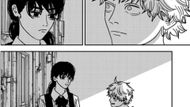Chainsaw Man Chapter 217 delivers one of the most emotionally powerful and introspective moments in Part 2, showing how far Fujimoto has come in developing Asa Mitaka and Denji not as weapons or devils, but as two deeply broken individuals trying to heal.
The chapter takes readers deep into Asa’s suppressed memories, the source of her guilt and self-loathing that has shaped her since Part 2 began. Through a haunting flashback, we see Asa’s childhood unfold by the riverbank, where her family encountered a weak devil. Her father tried to protect her but ended up gravely injured, losing his leg and bleeding out while her mother screamed for Asa to fetch help. In a moment that defines her forever, Asa trips on her way to get aid.

That simple fall, a recurring motif in her life, becomes symbolic of her guilt. When she returns, her father is dead, not from the devil, but from her mother’s hand. Asa’s mother later justifies her action as both practical and desperate: Her husband was abusive, unemployed, and a burden.
If he died by a devil’s hand, she could claim insurance money, securing Asa’s future. But in that moment, Asa realizes something devastating: Her own subconscious tripping may have been intentional. This revelation in Chainsaw Man Chapter 217 reframes the entire narrative surrounding Asa’s “clumsiness.” Was her tripping just bad luck, or was it her coping mechanism, a way to avoid blame for life-and-death choices?
From killing Bucky to losing her mother during the Typhoon Devil attack, each “accident” now reads like a psychological defense. Asa’s guilt is her curse, and this chapter forces her to confront that truth.
Denji’s mirroring trauma

While Asa’s trauma revolves around guilt and helplessness, Denji’s is rooted in violence and survival. Chainsaw Man Chapter 217 draws a brilliant parallel between the two, showing that both have carried the weight of parental trauma and moral confusion.
For Denji, the haunting “door” from Part 1 has always symbolized his inability to face what happened with his father. We now see him openly acknowledge the truth, that he killed his father, not out of hatred, but in self-defense.
Like Asa, Denji has lived with the belief that this act defines him, shaping his fear of intimacy and his need to appear “normal.” But when Asa confides her story, something shifts. Denji doesn’t recoil. He doesn’t judge. Instead, he meets her confession with empathy, the same empathy he has always craved but never received.
His response is simple yet profound: he still believes he’s a good person despite what he’s done. That perspective, coming from someone who has lived through hell, gives Asa a lifeline, permission to forgive herself.
Fujimoto’s exploration of shared pain in Chainsaw Man Chapter 217

What makes Chainsaw Man Chapter 217 exceptional isn’t just the backstory or the dialogue, but how Fujimoto stages this interaction. Both Asa and Denji are caught in a surreal mental landscape, separated from their devil counterparts, as if the world itself has paused to let them speak their truths. It is not a battle of strength, but of survival, emotional survival.
Fujimoto often uses devils as metaphors for human emotion, but here, the “devil” is guilt itself. Asa’s need to trip, Denji’s refusal to open the door, these are physical manifestations of repressed trauma. In giving them space to speak freely, Fujimoto allows the two characters to symbolically “meet” at the same emotional wavelength.
And for the first time, Asa isn’t alone in her pain. Throughout Part 2, she has been defined by isolation, her inability to connect, her resentment toward others, and her belief that no one could understand her suffering. Denji breaks that barrier. Their trauma becomes a bridge instead of a wall.
The brilliance of Chainsaw Man Chapter 217 lies in its quietness. Fujimoto doesn’t need gore or chaos to make the story compelling; he just lets two people talk. And in doing so, he proves that the real horror of Chainsaw Man has always been human nature, and the real redemption comes from empathy.
